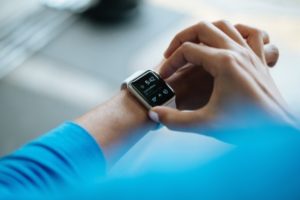Find out what you could potentially gain — and what to consider
 Wearable device use is continuing to grow — in 2016, 265 million wearable units were sold; a forecast from Gartner suggests that number may reach 504 million by 2021.
Wearable device use is continuing to grow — in 2016, 265 million wearable units were sold; a forecast from Gartner suggests that number may reach 504 million by 2021.
Given wearables’ popularity, it was only a matter of time before the technology found its way into the business world.
The devices aren’t commonplace office items just yet; however, for the past several years, a number of employers have been testing out ways activity trackers, sensor-based monitors and other wearable tech devices may be able to help improve operations — for example:
Enhancing communications
National retailer The Container Store debuted a voice-controlled wearable item for retail employees in 2016. Designed to streamline operations and increase efficiency and customer service, the system replaced the walkie-talkies and overhead announcements store employees previously had used to obtain and share information. The wearable device let Container Store employees, for instance, look up SKU numbers to check inventory without having to walk away from customers.
Increasing safety
Steel producer North Star Bluescope Steel has worked with IBM to create a wearable device technology that helps increase safety in dangerous environments. Sensors in helmets and wristbands gather data that can be analyzed to provide real-time alerts to employees and their managers, letting them know if their physical well-being is being compromised, according to IBM. The system also allows North Star to gauge hazardous situations that could potentially be overlooked, such as heightened skin temperature and heart rate, coupled with a lack of movement, which could indicate a person is suffering from heat stress.
Encouraging health and wellness
 The number of companies that incorporate wearable device technology into their wellness program — 35 percent, according to a Springbuk survey — increased by 10 percent from 2015 to 2017. BP, for instance, has a Million Step Challenge, in which employees earn 250 points for each million steps that are tracked. Earning 1,000 or more points qualifies workers and a spouse or domestic partner for what the company says are the best medical plan options.
The number of companies that incorporate wearable device technology into their wellness program — 35 percent, according to a Springbuk survey — increased by 10 percent from 2015 to 2017. BP, for instance, has a Million Step Challenge, in which employees earn 250 points for each million steps that are tracked. Earning 1,000 or more points qualifies workers and a spouse or domestic partner for what the company says are the best medical plan options.
Research suggests organizations may benefit from tying device use into health and wellness initiatives. Companies that track health indicators with wearable tech devices can reduce overall employee health costs, according to 62 percent of the businesses that have a health and wellness program, according to a 2016 Aflac report.
However, while 65 percent of employees feel the technology has a real role to play in their health and well-being, according to a 2016 PwC survey, more than a third, 38 percent, don’t trust their employer to use data it collects from employees wearing wearables in the workplace in a beneficial way. One potential solution: A quarter of those workers say they’d be willing to share their information if given an incentive, such as flexible hours or increased pay.
Some concerns exist about wearable use — such as privacy issues that could arise if the information devices gather isn’t transmitted or stored properly. A recent survey from Spiceworks found IT professionals say wirelessly connected, sensor-based devices pose the greatest threat to a network; more than 35 percent say wearable tech devices and sensors are highly vulnerable to Wi-Fi based cyberattacks. Workers may also feel having their every move be monitored throughout the day is an invasion of privacy.
Companies that decide to use wearables in the workplace will need to take local data protection legislation requirements into consideration, particularly in regard to the recently enacted EU General Data Protection Regulation security and compliance requirements.
If wearable device technology doesn’t seem like a good fit for your organization, there are other ways to engage motivate employees. Our blog posts on which employee satisfaction drivers to watch, 3 things your employee engagement program needs, why employers need to start enforcing employee time off and avoiding unexpected threats that can crush employee happiness may help.